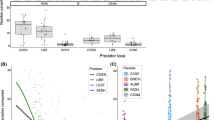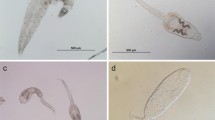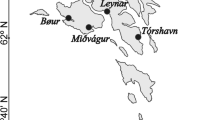Abstract
Within food webs, trophically transmitted helminth parasites use predator–prey links for their own transfer from intermediate prey hosts, in which they occur as larval or juvenile stages, to predatory definitive hosts, in which they reach maturity. In large taxa that can be used as intermediate and/or definitive hosts, such as fish, a host species’ position within a trophic network should determine whether its parasite fauna consists mostly of adult or larval helminths, since vulnerability to predation determines an animal’s role in predator–prey links. Using a large database on the helminth parasites of 303 fish species, we tested whether the proportion of parasite species in a host that occur as larval or juvenile stages is best explained by their trophic level or by their body size. Independent of fish phylogeny or habitat, only fish body length emerged as a significant predictor of the proportion of parasites in a host that occur as larval stages from our multivariate analyses. On average, the proportion of larval helminth taxa in fish shorter than 20 cm was twice as high as that for fish over 100 cm in length. This is consistent with the prediction that small fishes, being more vulnerable to predation, make better hosts for larval parasites. However, trophic level and body length are strongly correlated among fish species, and they may have separate though confounded effects on the parasite fauna exploiting a given species. Helminths show varying levels of host specificity toward their intermediate host when the latter is the downstream host involved in trophic transmission toward an upstream definitive host. Given this broad physiological compatibility of many helminths with fish hosts, our results indicate that fish body length, as a proxy for vulnerability to predators, is a better predictor of their use by helminth larvae than their trophic level based on diet content.



Similar content being viewed by others
References
Amundsen P-A, Lafferty KD, Knudsen R, Primicerio R, Klemetsen A, Kuris AM (2009) Food web topology and parasites in the pelagic zone of a subarctic lake. J Anim Ecol 78:563–572
Arai MN, Welch DW, Dunsmuir AL, Jacobs MC, Ladouceur AR (2003) Digestion of pelagic Ctenophora and Cnidaria by fish. Can J Fish Aquat Sci 60:825–829
Chen H-W, Liu W-C, Davis AJ, Jordán F, Hwang M-J, Shao K-T (2008) Network position of hosts in food webs and their parasite diversity. Oikos 117:1847–1855
Cohen JE, Pimm SL, Yodzis P, Saldana J (1993) Body sizes of animal predators and animal prey in food webs. J Anim Ecol 62:67–78
Froese R, Pauly D (2010) Fishbase (version 03/2010). Available from http://www.fishbase.org
George-Nascimento MA (1987) Ecological helminthology of wildlife animal hosts from South America: a literature review and a search for patterns in marine food webs. Rev Chil Hist Nat 60:181–202
Gerking SD (1994) Feeding ecology of fish. Academic, San Diego
Gregory RD, Keymer AE, Harvey PH (1996) Helminth parasite richness among vertebrates. Biodiv Conserv 5:985–997
Hernandez AD, Sukhdeo MVK (2008) Parasites alter the topology of a stream food web across seasons. Oecologia 156:613–624
Huxham M, Raffaelli D, Pike A (1995) Parasites and food web patterns. J Anim Ecol 64:168–176
Hyndes GA, Platell ME, Potter IC (1997) Relationships between diet and body size, mouth morphology, habitat and movements of six sillaginid species in coastal waters: implications for resource partitioning. Mar Biol 128:585–598
Jennings S, Pinnegar JK, Polunin NVC, Boon TW (2001) Weak cross-species relationships between body size and trophic level belie powerful size-based trophic structuring in fish communities. J Anim Ecol 70:934–944
Jensen K, Bullard SA (2010) Characterization of a diversity of tetraphyllidean and rhinebothriidean cestode larval types, with comments on host associations and life-cycles. Int J Parasitol 40:889–910
Lafferty KD, Allesina S, Arim M, Briggs CJ, De Leo G, Dobson AP, Dunne JA, Johnson PTJ, Kuris AM, Marcogliese DJ, Martinez ND, Memmott J, Marquet PA, McLaughlin JP, Mordecai EA, Pascual M, Poulin R, Thieltges DW (2008) Parasites in food webs: the ultimate missing links. Ecol Lett 11:533–546
Leung TLF, Poulin R (2008) Size-dependent pattern of metacercariae accumulation in Macomona liliana: the threshold for infection in a dead-end host. Parasitol Res 104:177–180
Link J (2002) Does food web theory work for marine ecosystems? Mar Ecol Progr Ser 230:1–9
Locke SA, McLaughlin JD, Marcogliese DJ (2010) DNA barcodes show cryptic diversity and a potential physiological basis for host specificity among Diplostomoidea (Platyhelminthes: Digenea) parasitizing freshwater fishes in the St. Lawrence River, Canada. Mol Ecol 19:2813–2827
Luque JL, Poulin R (2004) Use of fish as intermediate hosts by helminth parasites: a comparative analysis. Acta Parasitol 49:353–361
Luque JL, Poulin R (2008) Linking ecology with parasite diversity in Neotropical fishes. J Fish Biol 72:189–204
Marcogliese DJ (2002) Food webs and the transmission of parasites to marine fish. Parasitology 124:S83–S99
Marcogliese DJ, Cone DK (1997) Food webs: a plea for parasites. Trends Ecol Evol 12:320–325
Margolis L, Arthur JR (1979) Synopsis of the parasites of fishes of Canada (Bull Fisher Res Board Canada no. 199). Department of Fisheries and Oceans Canada, Ottawa
McClelland G (2002) The trouble with sealworms (Pseudoterranova decipiens species complex, Nematoda): a review. Parasitology 124:S183–S203
McDonald TE, Margolis L (1995) Synopsis of the parasites of fishes of Canada: supplement (1978–1993; Canadian Spec Publ Fisher Aquat Sci no. 122). National Research Council of Canada, Ottawa
Morand S, Arias-Gonzalez E (1997) Is parasitism a missing ingredient in model ecosystems? Ecol Model 95:61–74
Pasternak AF, Huntingford FA, Crompton DWT (1995) Changes in metabolism and behaviour of the freshwater copepod Cyclops strenuus abyssorum infected with Diphyllobothrium spp. Parasitology 110:395–399
Poulin R (1995) Phylogeny, ecology, and the richness of parasite communities in vertebrates. Ecol Monogr 65:283–302
Poulin R (1997) Species richness of parasite assemblages: evolution and patterns. Annu Rev Ecol Syst 28:341–358
Poulin R (2000) Variation in the intraspecific relationship between fish length and intensity of parasitic infection: biological and statistical causes. J Fish Biol 56:123–137
Poulin R (2004) Macroecological patterns of species richness in parasite assemblages. Basic Appl Ecol 5:423–434
Poulin R (2010) Network analysis shining light on parasite ecology and diversity. Trends Parasitol 26:492–498
Poulin R, Leung TLF (2010) Taxonomic resolution in parasite community studies: are things getting worse? Parasitology 137:1967–1973
Pulkkinen K, Pasternak AF, Hasu T, Valtonen ET (2000) Effect of Triaenophorus crassus (Cestoda) infection on behavior and susceptibility to predation of the first intermediate host Cyclops strenuus (Copepoda). J Parasitol 86:664–670
Sasal P, Morand S, Guégan J-F (1997) Determinants of parasite species richness in Mediterranean marine fish. Mar Ecol Progr Ser 149:61–71
Schoener TW (1989) Food webs from the small to the large. Ecology 70:1559–1589
Sukhdeo MVK (2010) Food webs for parasitologists: a review. J Parasitol 96:273–284
Sukhdeo MVK, Hernandez AD (2005) Food web patterns and the parasite’s perspective. In: Thomas F, Renaud F, Guégan J-F (eds) Parasitism and ecosystems. Oxford University Press, Oxford, pp 54–67
Thompson RM, Mouritsen KN, Poulin R (2005) Importance of parasites and their life cycle characteristics in determining the structure of a large marine food web. J Anim Ecol 74:77–85
Valtonen ET, Marcogliese DJ, Julkunen M (2010) Vertebrate diets derived from trophically transmitted fish parasites in the Bothnian Bay. Oecologia 162:139–152
Wainwright PC, Richard BA (1995) Predicting patterns of prey use from morphology of fishes. Env Biol Fish 44:97–113
Walther BA, Cotgreave P, Price RD, Gregory RD, Clayton DH (1995) Sampling effort and parasite species richness. Parasitol Today 11:306–310
Acknowledgments
We are grateful to Juan Timi and members of the Otago Ecological Parasitology Research Group for useful comments on an earlier draft of this manuscript, and in particular to one anonymous referee who provided very thoughtful suggestions. Financial support came in part via a grant from the Marsden Fund.
Author information
Authors and Affiliations
Corresponding author
Additional information
Communicated by David Marcogliese.
Electronic supplementary material
Below is the link to the electronic supplementary material.
Rights and permissions
About this article
Cite this article
Poulin, R., Leung, T.L.F. Body size, trophic level, and the use of fish as transmission routes by parasites. Oecologia 166, 731–738 (2011). https://doi.org/10.1007/s00442-011-1906-3
Received:
Accepted:
Published:
Issue Date:
DOI: https://doi.org/10.1007/s00442-011-1906-3




